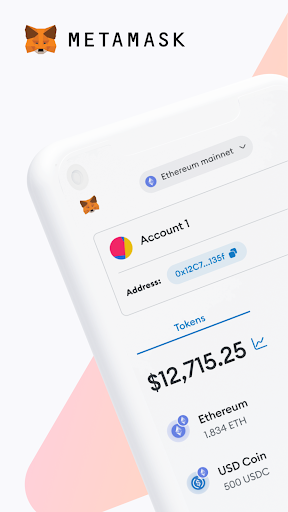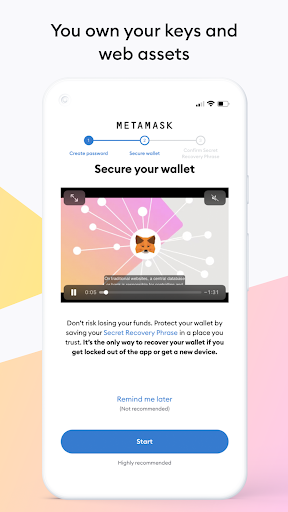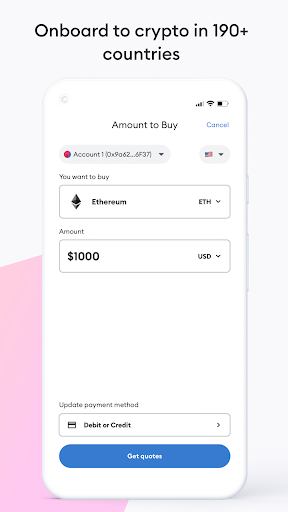| Metamask ★ 4.5 |
|
| ⚙️Developer | MetaMask Web3 Wallet |
| ⬇️Downloads | 100,000,000+ |
| 📊Category | Finance |
| 🤖Tags | cryptocurrency | ethereum | wallet |
The Metamask app is a powerful tool that allows users to interact with the Ethereum blockchain and access decentralized applications (dApps) directly from their web browsers. With Metamask, users can securely manage their Ethereum wallets, send and receive Ether (ETH), and seamlessly engage with the world of decentralized finance (DeFi). As one of the most popular Ethereum wallets and browser extensions, Metamask has gained a strong following among cryptocurrency enthusiasts and developers alike. In this article, we will explore the features, benefits, pros, and cons of the Metamask app.
Features & Benefits
- Ethereum Wallet Management: Metamask serves as a user-friendly Ethereum wallet, allowing users to create and manage multiple accounts. It provides a secure environment for storing private keys and enables users to easily access their wallets from different devices.
- Seamless dApp Integration: Metamask integrates seamlessly with various decentralized applications built on the Ethereum network. Users can interact with dApps directly from their browsers without the need for separate installations or complex configurations.
- Secure Transaction Execution: Metamask ensures secure transactions by prompting users to review and confirm each transaction before it is executed. This feature helps prevent accidental or unauthorized transfers of Ether and provides an additional layer of security.
- Customizable Gas Fees: Metamask allows users to adjust the gas fees associated with their transactions. This flexibility enables users to prioritize transaction speed or cost efficiency based on their individual needs and preferences.
- Browser Compatibility: Metamask is compatible with popular web browsers such as Chrome, Firefox, and Brave. This broad compatibility makes it accessible to a wide range of users, regardless of their preferred browser.
Pros & Cons
Metamask Faqs
If you forget your MetaMask password, there is no way to recover it directly, as MetaMask does not store your passwords. However, if you have your recovery seed phrase (also known as the secret backup phrase), you can reset your wallet. To do this, uninstall and reinstall the MetaMask app or extension, choose the option to restore an existing wallet, and enter your recovery seed phrase. This will allow you to access your wallet again, but you will need to create a new password. To add custom tokens in your MetaMask wallet, first ensure that you are logged into your account. Click on the “Assets” tab, then scroll down and select “Import Tokens.” In the next screen, click on “Custom Token.” You¡¯ll need to enter the token contract address, which you can find on websites like Etherscan. Once you’ve entered the address, MetaMask will auto-fill the Token Symbol and Decimals of Precision. After confirming, click ¡°Add Custom Token¡± and then ¡°Import Tokens.¡± The token will now appear in your asset list. MetaMask is generally considered secure for holding cryptocurrency, especially for smaller amounts and for frequent transactions. However, keeping large sums in any online wallet poses a risk due to potential hacks or phishing scams. For significant amounts, it’s advisable to use a hardware wallet for enhanced security. Always ensure you follow best practices, such as enabling two-factor authentication on your email and using strong, unique passwords. MetaMask primarily supports Ethereum and ERC-20 tokens, which means direct transfers between different blockchains (such as Bitcoin or Binance Smart Chain) are not possible within the app itself. However, you can use cross-chain bridges or decentralized exchanges to facilitate transfers. Make sure you¡¯re aware of transaction fees and potential delays when using these services. If you’re having trouble connecting MetaMask to specific decentralized applications (dApps), check several factors: Ensure that you are using the correct network (e.g., Ethereum Mainnet, Binance Smart Chain), verify that the dApp is compatible with MetaMask, and clear your browser’s cache if you’re using the extension. Additionally, make sure that pop-ups are enabled for your browser since some dApps require them to establish connections. To protect your MetaMask account from phishing attacks, never share your recovery seed phrase or private keys with anyone. Use only official links to access MetaMask and be cautious of unsolicited chat messages or emails requesting sensitive information. Consider regularly updating your passwords and using a dedicated device for crypto transactions. Additionally, enable hardware wallets for added security whenever possible. If you send tokens to the wrong address, unfortunately, there’s no way to reverse the transaction or retrieve your tokens if the recipient does not return them. Always double-check the recipient address before confirming any transaction. If the address belongs to another wallet under your control, you can check that wallet for your funds. If the tokens were sent to the wrong address on a different blockchain, recovery may be significantly more complicated. Updating your MetaMask app varies based on the platform you’re using. For the browser extension, updates typically occur automatically; however, you can manually check by going to the chrome://extensions page, enabling Developer mode, and clicking ¡°Update.¡± For mobile users, visit the App Store (iOS) or Google Play Store (Android) and check for updates. Regularly updating helps ensure you have the latest features and security patches.What should I do if I forget my MetaMask password?
How can I add custom tokens to my MetaMask wallet?
Is it safe to store large amounts of cryptocurrency in MetaMask?
Can I transfer tokens between different blockchains using MetaMask?
Why is my MetaMask not connecting to certain dApps?
How do I secure my MetaMask account against phishing attacks?
What should I do if I accidentally sent tokens to the wrong address using MetaMask?
How can I update my MetaMask app to the latest version?
Alternative Apps
Exodus Wallet: Exodus Wallet is a desktop and mobile wallet that supports a wide range of cryptocurrencies. It provides users with full control over their private keys and offers a built-in exchange for easy token swaps.
Trezor Wallet: Trezor Wallet is a hardware wallet that offers secure storage and management of cryptocurrencies. It supports multiple blockchains and provides users with a user-friendly interface for accessing their funds.
Atomic Wallet: Atomic Wallet is a decentralized multi-currency wallet that provides users with full control over their private keys. It supports a wide range of cryptocurrencies and offers built-in atomic swaps for easy token exchanges.
MyEtherWallet: MyEtherWallet is a popular web-based wallet designed specifically for Ethereum and ERC-20 tokens. It allows users to securely manage their Ethereum assets and interact with decentralized applications.
Ledger Live: Ledger Live is a desktop and mobile wallet designed for users of the Ledger hardware wallets. It provides a secure way to manage cryptocurrencies and offers integration with popular DeFi platforms.
Screenshots
 |
 |
 |
 |


